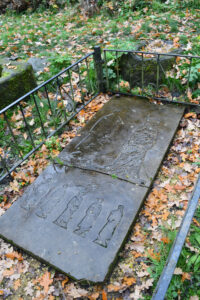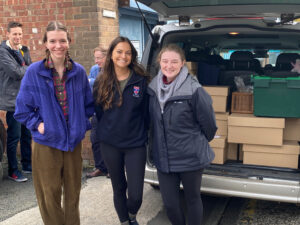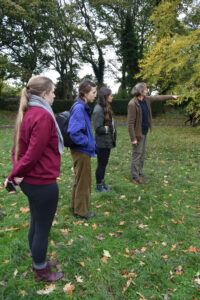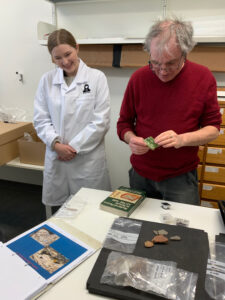St Leonards Hospital North Shields
 2024 Update: The documentation of the St Leonard’s North Shields skeletal assemblage has been completed. Honours students in Alison’s History and Archaeology of Medieval Monasticism Module at St Andrews will be designing an exhibit featuring all aspects of the St Leonards excavations to pitch to the University’s Wardlaw Museum!
2024 Update: The documentation of the St Leonard’s North Shields skeletal assemblage has been completed. Honours students in Alison’s History and Archaeology of Medieval Monasticism Module at St Andrews will be designing an exhibit featuring all aspects of the St Leonards excavations to pitch to the University’s Wardlaw Museum!
Exploring the Human Dimensions of a Medieval Hospital
In 2011, 2013, and 2014, excavations were carried out at the site of a medieval hospital dedicated to St Leonard in North Shields, not far from the much better-known Tynemouth Priory (f. 7th c). These brief community-based digs took place under the direction of archaeologist Richard Carlton of The Archaeological Practice in Newcastle upon Tyne.
The historical background St Leonards North Shields cannot be securely reconstructed from surviving documents. The institution was first mentioned in the assize rolls of 1293, and Knowles and Hancock (1971) claimed that the hospital was staffed by “resident sisters” — presumably a community of nuns who served the hospital. The Suppression of 1536 lists “nuns of Tynemouth” among the smaller religious houses dissolved (Henry VIII, X, 36). Were there nuns at St Leonards in North Shields? #TeamNun is still hard at work on this puzzle using textual sources, archaeology, and bio-archaeology down to the microscopic level!
Nuns or no, the St Leonards site offers a fascinating view into the world of a medieval hospital.
 After the last burials at the site in the seventeenth century, the site fell into total obscurity. Excavations were carried out in 1885 during the construction of Northumberland Park and the remains of what may have been a range of hospital buildings was discovered. Human remains were also found. The modern community excavations focused on the hospital cemetery. At the end of the 2014 excavations, the hospital chapel was discovered. The excavation was briefly extended so that the full extent of the chapel could be exposed. Some of the burials that were discovered under the floor of the church — some cut into thirteenth-century floor tiles — were also excavated.
After the last burials at the site in the seventeenth century, the site fell into total obscurity. Excavations were carried out in 1885 during the construction of Northumberland Park and the remains of what may have been a range of hospital buildings was discovered. Human remains were also found. The modern community excavations focused on the hospital cemetery. At the end of the 2014 excavations, the hospital chapel was discovered. The excavation was briefly extended so that the full extent of the chapel could be exposed. Some of the burials that were discovered under the floor of the church — some cut into thirteenth-century floor tiles — were also excavated.
In the fall of 2022, the human remains excavated from St Leonards in 2013 and 2014 were entrusted  to our research team at St Andrews for a more complete study and cataloging. What an amazing adventure it has been! After six months of collegial hospitality in the Department of Anatomy within the School of Medicine, we are are now continuing our full re-examination of the remains in our own archaeological lab at St Andrews.
to our research team at St Andrews for a more complete study and cataloging. What an amazing adventure it has been! After six months of collegial hospitality in the Department of Anatomy within the School of Medicine, we are are now continuing our full re-examination of the remains in our own archaeological lab at St Andrews.
Our work is supported by an innovative academic partnership with osteologists and palaeopathologists from the University of Turin. Following a two-week intensive training and research visit with doctoral student in osteology Sarah Sandron, osteologist and paleopathologist Dr Rosa Boano travelled to St Andrews to offer a masterclass sponsored by the School of History on osteology for PG students and staff at the university. Twenty-four students spent the afternoon learning about what the human skeleton can tell historians about the lives of past individuals.
Our team of students and staff continue to work with our colleagues in Turin through research and training visits and video consultations.
Our work in the lab is also supported by other wonderful visiting experts!
Archaeologist Derek Hall, a specialist in medieval ceramics, has also visited the lab to examine and  characterize the pottery excavated within the grave cuts. Derek also has extensive field experience (this is an understatement…!) with the excavation of human remains, and we are looking forward to his upcoming #TeamNun lecture on the proper excavation and recording of burials.
characterize the pottery excavated within the grave cuts. Derek also has extensive field experience (this is an understatement…!) with the excavation of human remains, and we are looking forward to his upcoming #TeamNun lecture on the proper excavation and recording of burials.
Dr Amy Ladd, professor of orthopedic surgery at Stanford University and a specialist in the human hand has visited the lab twice to discuss the skeletal anatomy of hands and teach us about evidence of pathologies such as osteoarthritis — potential sources of information about the labour-related activities of the individual under study. In Spring 2023 we had an amazing afternoon of hands-on (!) training in identifying and laying out the bones of the hand — followed by absolutely delicious cake provided by Dr Ladd! We are now working on ideas for collaborating on a project that would approach the human hand from a number of cultural and material angles. And not just because of the cake.

The St Leonards project has inspired St Andrews PhD student Christine Masternak to undertake a broader investigation of medieval hospitals. Her doctoral thesis is a study of hospitals in the twelfth and thirteenth centuries in the Scottish Borderlands — specifically, the (modern) counties of Northumberland (England, where St Leonards is located), Berwick, Roxburgh, Selkirk, Peebles, and East Lothian. Her work focuses on patterns of dedication and foundation, as well as on the archaeology of the hospitals themselves.
Our research will be featured in the School of History’s exhibition for Disability History Month in the fall of 2023. We are also planning a spring 2023 exhibit and research residency in the Research Studio and Learning Loft at the University’s Wardlaw Museum.
At the end of the study, the remains will be reburied at their original site in North Shields.
